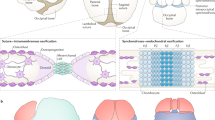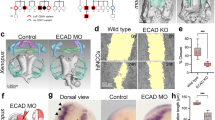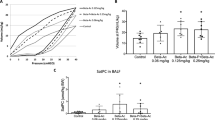Abstract
CLEFT secondary palate can be induced experimentally in various mammalian species by the administration of glucocorticoids to pregnant animals1–4. The well known differences in susceptibility to cortisone-induced cleft palate in inbred strains of mice have been explained in terms of genetic differences in foetal facial mesenchymal glucocorticoid receptor levels5,6. The quantity of one protein in particular, with an isoelectric point (pI) of approximately 7.0, seems to be correlated rather closely with the susceptibility of various strains to cortisone-induced cleft palate6. It has also been shown that much of the difference in cleft palate susceptibility between C57BL/10 (B10) and A/J mice can be accounted for by H–2-linked genes7,8, and that there is H–2-linked variation in the level of cortisol-binding proteins obtained from the cytosol fraction of foetal palatal tissue6. As corticoids form a specific cytoplasmic cortisol receptor complex in target tissues which interacts with the genome resulting in activation or depression of transcription9,10, a product of a gene in or near the H–2 locus seems to be the glucocorticoid receptor, the level of which has to be raised for cleft palate to occur. As a first step to determine whether such a mechanism may operate in humans, we have examined whether human palatal mesenchymal cells, obtained in cultures from foetuses shortly after the critical period of secondary palatal closure, contain glucocorticoid receptors. We show here that these cells have specific glucocorticoid receptor proteins with high affinity for dexamethasone and triamcinolone acetonide, and that dexamethasone is displaced from its binding sites only by drugs which produce cleft palate in sensitive mouse strains. Thus, the human foetus contains an active glucocorticoid receptor mechanism immediately after the critical period of palatal organogenesis, which may be involved in palatal clefting.
This is a preview of subscription content, access via your institution
Access options
Subscribe to this journal
Receive 51 print issues and online access
$199.00 per year
only $3.90 per issue
Buy this article
- Purchase on Springer Link
- Instant access to full article PDF
Prices may be subject to local taxes which are calculated during checkout
Similar content being viewed by others
References
Baxter, H. & Fraser, F. C. McGill med. J. 19, 245–249 (1950).
Shah, R. M. & Travill, A. A. Teratology 13, 71–84 (1976).
Fainstat, T. D. Endocrinology 55, 502–508 (1954).
Fraser, S. C., Kalter, H., Walker, B. E. & Fainstat, T. D. J. cell. comp. Physiol. 43, Suppl. 1, 237–259 (1954).
Salomon, D. S. & Pratt, R. M. Nature 264, 174–177 (1976).
Goldman, A. S., Katsumata, M., Yaffe, S. J. & Gasser, D. L. Nature 265, 643–645 (1977).
Bonner, J. J. & Slavkin, H. C. Immunogenetics 2, 213–218 (1975).
Biddle, F. G. & Fraser, F. C. Genetics 85, 289–302 (1977).
Beato, M., Homoki, J. & Sekeris, C. E. Expl Cell Res. 55, 107–111 (1969).
Munck, A. J. biol. Chem. 243, 1039–1042 (1968).
Litwack, G. et al. J. biol. Chem. 248, 7481–7486 (1973).
Rousseau, G. G., Baxter, J. D. & Tomkins, G. M. J. molec. Biol. 67, 99–115 (1972).
Schmid, W., Grote, H. & Sekeris, C. E. Molec. cell. Endocr. 5, 223–241 (1976).
Walker, B. E. & Patterson, A. Teratology 10, 159–164 (1974).
Massey, K. M. J. oral Ther. 2, 380–385 (1966).
Lambert, G. H. & Nevert, D. W. Teratology 16, 147–153 (1977).
Kimmel, G. L., Hartwell, B. S. & Andrew, F. D. Teratology 13, 28, abstr. (1976).
Rolf, B. B. Am. J. Obstet. Gynec. 95, 339–344 (1966).
Bongiovanni, A. M. & McPadden, Fert. Steril. 11, 181–186 (1960).
Popert, A. J. Br. med. J. 1, 967–971 (1962).
Fraser, F. C. Br. med. J. 2, 479–483 (1962).
Serment, H. & Ruf, H. Bull. Fedn Soc. Gynec. Obstet. Lang. Fr. 20, 77–85 (1968).
Hanson, J. W. & Smith, D. W. J. Pediat. 87, 285–295 (1976).
Kolata, G. S. Science 197, 36–37 (1977).
Baxter, J. D., Higgins, S. J. & Rousseau, G. G. in Methods in Enzymology, 36 (eds O'Malley, B. W. & Hardman, J. G.) (Academic, New York, 1975).
Sibley, C. H. & Tomkins, G. M. Cell 2, 221–227 (1974).
Katsumata, M. & Goldman, A. S. Biochim. biophys. Acta 359, 112–129 (1974).
Maggio, R., Siekevitz, P. & Palade, G. E. J. Cell Biol. 18, 267–291 (1963).
Author information
Authors and Affiliations
Rights and permissions
About this article
Cite this article
GOLDMAN, A., SHAPIRO, B. & KATSUMATA, M. Human foetal palatal corticoid receptors and teratogens for cleft palate. Nature 272, 464–466 (1978). https://doi.org/10.1038/272464a0
Received:
Accepted:
Published:
Issue Date:
DOI: https://doi.org/10.1038/272464a0
This article is cited by
-
Prenatal Treatment of Congenital Adrenal Hyperplasia—Not Standard of Care
Journal of Genetic Counseling (2012)
-
Prenatal diagnosis and treatment of congenital adrenal hyperplasia owing to 21-hydroxylase deficiency
Nature Clinical Practice Endocrinology & Metabolism (2007)
-
Teratogenicity screening in standardized chick embryo culture: Effects of dexamethasone and diphenylhydantoin
Experientia (1988)
-
Polycystic kidney and liver disease and corticosterone changes in the cpk mouse
Kidney International (1987)
-
Treatment of idiopathic thrombocytic purpura in pregnancy by high-dose intravenous immunoglobulin
Blut (1983)
Comments
By submitting a comment you agree to abide by our Terms and Community Guidelines. If you find something abusive or that does not comply with our terms or guidelines please flag it as inappropriate.



